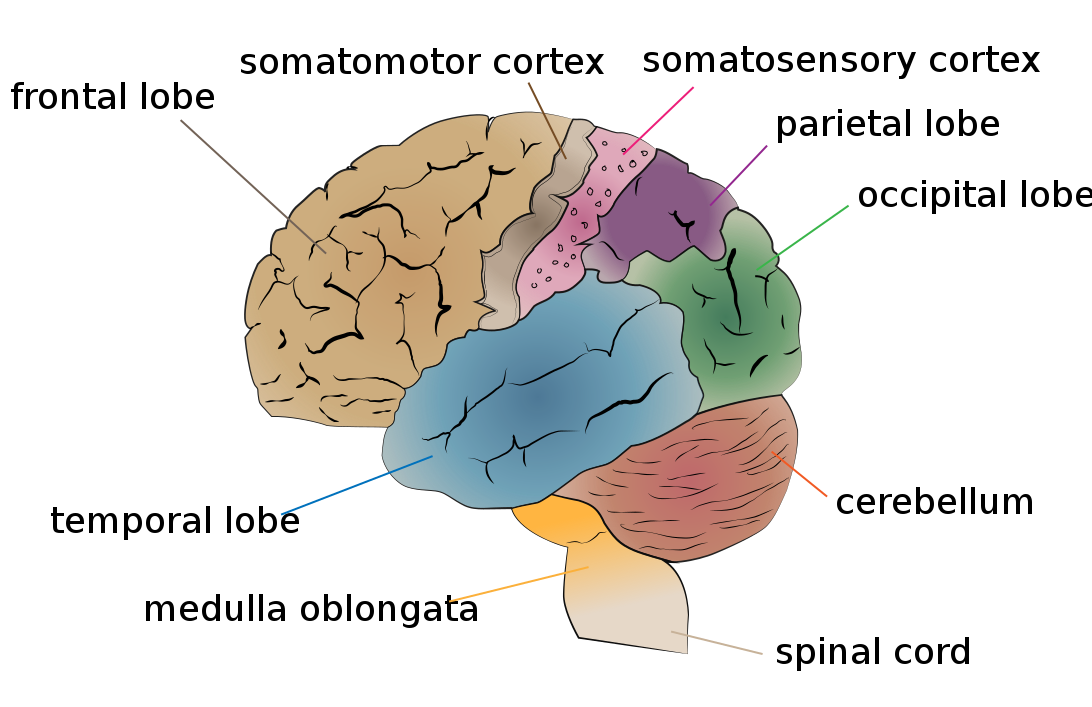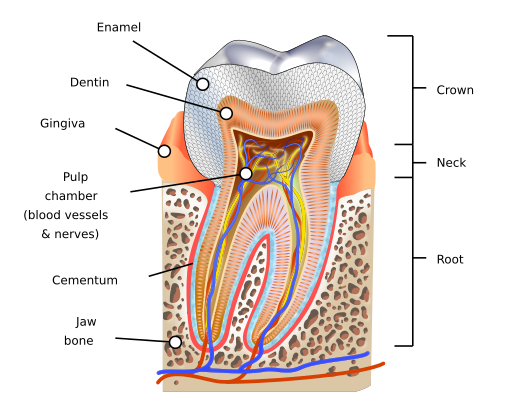Human brain/Printable version
| This is the print version of Human brain You won't see this message or any elements not part of the book's content when you print or preview this page. |
The current, editable version of this book is available in Wikibooks, the open-content textbooks collection, at
https://en.wikibooks.org/wiki/Human_brain
Cerebrum
Anatomy
[edit | edit source]The cerebrum is made up of 4 lobes:
- Frontal lobe
- Parietal lobe
- Occipital lobe
- Temporal lobe
The cerebrum is the largest part of the brain.

Function
[edit | edit source]The cerebrum controls our thinking and our muscles. It stores all memories.
Cerebellum
Anatomy
[edit | edit source]The cerebellum (Latin for little brain) is made up of the cerebrocerebellum, the spinocerebellum, and the vestibulocerebellum.
Function
[edit | edit source]The cerebellum controls your posture and your balance.
Brainstem
Anatomy
[edit | edit source]The brainstem is made up of the midbrain, the pons, and the medulla (medulla oblongata).

Function
[edit | edit source]The brainstem controls your heart and lungs.
Eye
Anatomy
[edit | edit source]The parts of your eye are:
- Sclera
- Cornea
- Retina
- Anterior chamber
- Posterior chamber
- Iris
- Pupil
- Lens
- Vitreous body
- Optic nerve
Function
[edit | edit source]Your eyes help you see color.
Color
[edit | edit source]This is the advanced level. The different colors represent what each of the colors looks like.
Primary
[edit | edit source]- Red
- Blue
- Yellow
Secondary
[edit | edit source]- Green
- Orange
- Purple
Tertiary
[edit | edit source]- Teal
- Violet
- Amber
- Magenta
- Chartreuse
- Vermilion
Light
[edit | edit source]Color is actually from sunlight. Without the sun, everything would be black, white, and grey.
Sight
[edit | edit source]Now that we learned about color, we need to learn how we see. When light enter the pupil, and is focused through the cornea, lens, and iris. Then the image focuses on the retina. There are 2 types of cells in vision: Rods and cones. Rods see black, white, and grey. Cones see colors.
Ear
Anatomy
[edit | edit source]The parts of the ear are:
- Pinna
- Ear canal
- Eardrum
- Ossicles
- Hammer
- Anvil
- Stirrup
- Cochlea
Function
[edit | edit source]When sound waves are made the pinna (auricle) gathers them up and then the sound waves move into the ear canal (external auditory meatus, EAM). The sound waves then vibrate the eardrum (tympanic membrane) which strikes the hammer (malleus) bone which moves the anvil (incus) bone and the stirrup (stapes) bone. The stapes vibrates the liquid that fills the cochlea. The hair cells at the bottom detect the highest sounds. The hair cells in the middle detect lower sounds. The hair cells at the top control the lowest sounds. This gets going to the auditory nerve and then into the brain where you hear the sound.
Illustrations
[edit | edit source]-
the pinna of the ear
-
ear canal highlighted
-
tympanic membrane
-
ossicles
-
cochlea
Nose
Anatomy
[edit | edit source]The parts of the nose are:
- Nasion
- Root
- Bridge
- Ala
- Apex
- Nostril
- Columella
- Nasal cavity
- Vestibule
- Olfactory region
- Respiratory region
Function
[edit | edit source]The air goes inside the nasal cavity. The nasal cavity warms the air and traps dust particles with tiny hairs and mucous. The smell of things in the air is caused by the olfactory tract which sends signals to the brain about the smell.
Epidermis
Anatomy
[edit | edit source]
The parts of the epidermis are:
- Stratum basale
- Stratum spinosum
- Stratum granulosum
- Stratum lucidum
- Stratum corneum
Function
[edit | edit source]The epidermis prevents microbes from entering the body. The epidermis is also waterproof, preventing the ingress of liquids which would otherwise wreck havoc on the chemistry body. After all, how would you wash your hands if they were not waterproof?
Dermis
Anatomy
[edit | edit source]The dermis is made up of the papillary dermis and the reticular dermis. It consists of collagen, elastin, blood capillaries, lymph vessels, sweat glands, sebaceous glands, nerve endings, and hair follicles.
Function
[edit | edit source]The dermis makes sweat and regulates the body’s temperature, it produces oil, it makes hair grow, feels things and if it is too hot or too cold, your body tells you to get away from it and the dermis also protects the body from harmful pathogens, keeping the skin in shape, and distributing blood so that it can feed the skin, removes toxins, and supplies the epidermis with blood.
Mouth
Tooth
[edit | edit source]Anatomy
[edit | edit source]The teeth (singular: tooth) are made up of parts shown below.
- Crown
- Enamel
- Dentin
- Neck
- Gingiva
- Pulp cavity
- Pulp
- Root
- Cementum
- Root canal
- Periodontal ligament
- Nerves and blood vessels
- Alveolar bone
- Jaw
- Maxillae
- Mandible
Function
[edit | edit source]The teeth function to chew food. The types of teeth are the incisors, canines, premolars, and molars. Incisors cut the food. The canines grip the food. The premolars and molars (from Latin: mola = grindstone) grind the food. A baby has 20 teeth, but they are not visible until they erupt through the gingiva (gums) and an adult has 32 teeth. Maxillary (upper) teeth and their associated periodontal ligament are innervated by the superior alveolar nerves, branches of the maxillary division, termed the posterior superior alveolar nerve, anterior superior alveolar nerve, and the variably present middle superior alveolar nerve. The teeth help us speak.
Salivary gland
[edit | edit source]Anatomy
[edit | edit source]The parotid, sublingual, and submandibular glands are major salivary glands. The other ones are minor salivary glands.
Function
[edit | edit source]The salivary glands make saliva. Saliva travels through ducts and then into the mouth.
Saliva
[edit | edit source]Saliva has alpha-amylase which breaks down starch and lingual lipase which breaks lipids. Saliva also cleans the mouth.
Lingua
[edit | edit source]Anatomy
[edit | edit source]The lingua (tongue) is made up of the base (root), body, and apex.
Function
[edit | edit source]The lingua helps in speech. Saliva helps taste the food. The chemicals from the food travel from the lingual papillae to the taste buds. The lingua and saliva from the food bolus. It gets sent down the pharynx.
Air
[edit | edit source]The mouth is also a passage for air.







